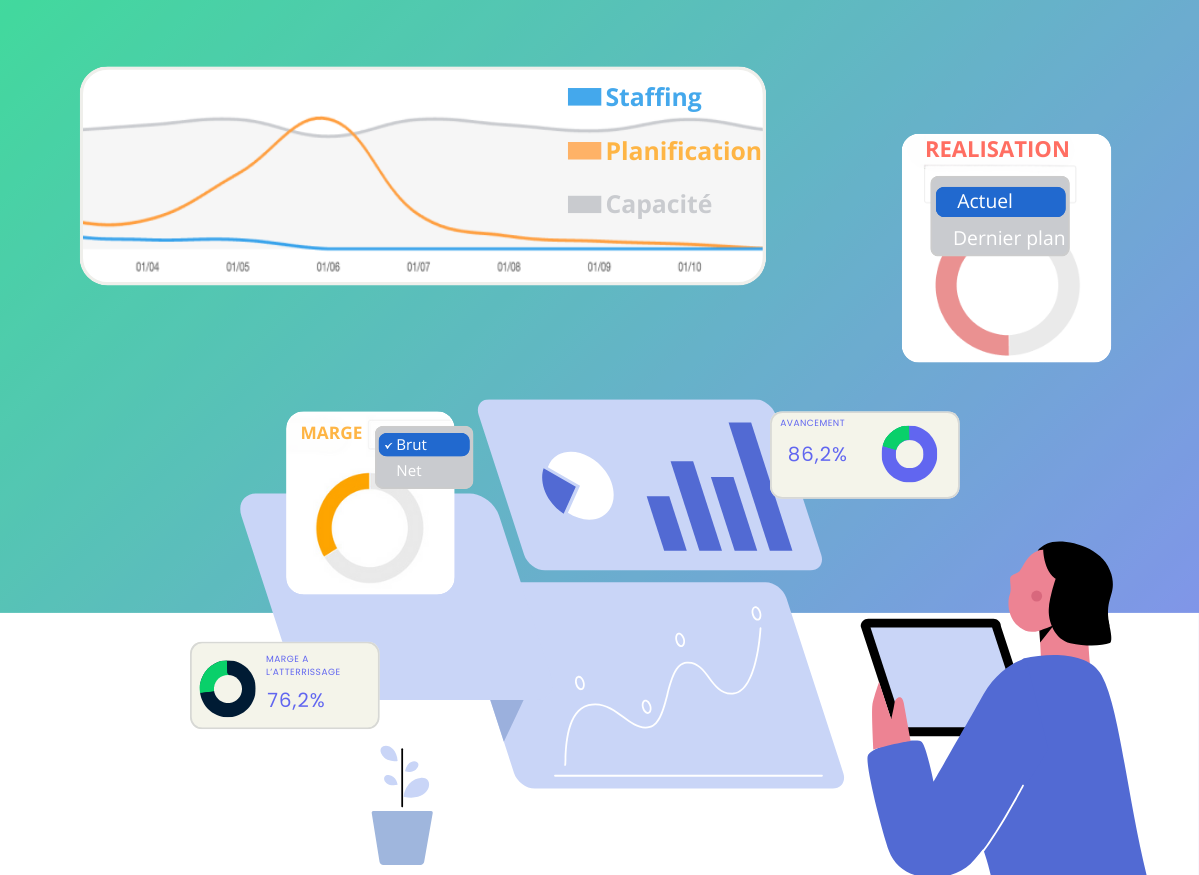What are the best timesheet software?
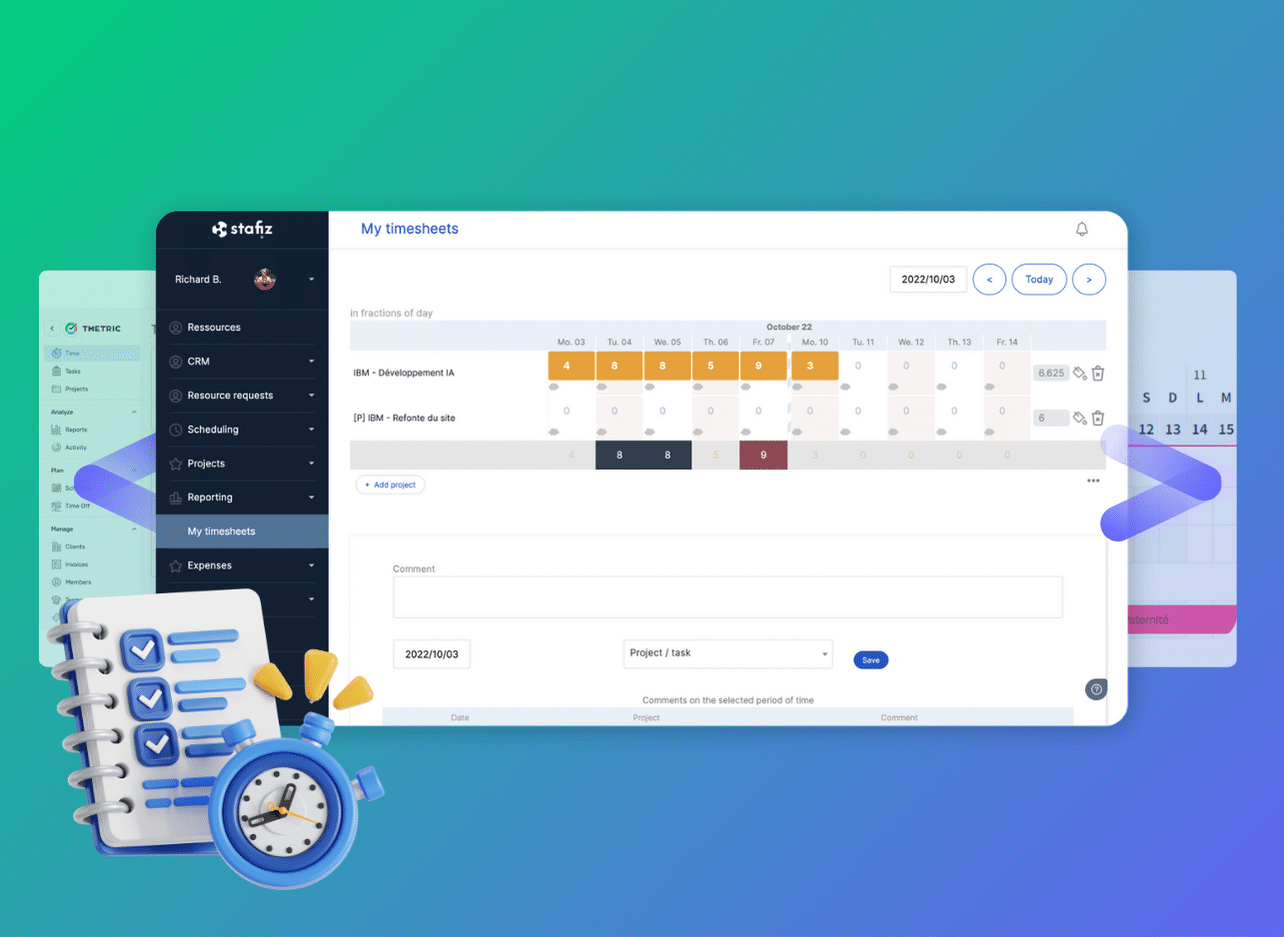
Choosing timesheet software is no longer just a matter of keeping track of hours: it is a strategic issue to control costs, make invoicing more reliable and improve the profitability of projects. Whether it's a simple online timesheet for a small team or a collaborative SaaS capable of managing hundreds of employees, the right tool becomes a real management lever.
Service companies, consulting firms, IT Services or freelancers often have to track working time by client, by assignment or by deliverable, in order to anticipate budget drifts and protect their margins. Modern solutions go beyond simple time recording: they connect time entry with schedules, expenses, invoicing and financial reporting, allowing for quick action on performance.
From billable timesheet software for freelancers to collaborative SaaS for SMEs, each solution meets specific needs: regulatory compliance, multi-project planning, automatic follow-up or customer invoicing. You will discover for each its functionalities, advantages, limitations and the company profiles to which it is best suited.
Software Comparison: Which Timesheet Software To Choose In 2025?
| Project time tracking | ✅ By activity / phase / project In Hours / Minutes / Day / % |
✅ By Activity / Project | ✅ By Activity / Project | ✅ By Activity | ✅ Auto (apps/files) | ✅ By Activity / Project | ✅ By Activity / Project |
| Online availability | ✅ Web & Mobile | ✅ Web & Mobile | ✅ Web & Mobile | ✅ Web | ❌ (desktop local) | ✅ Web | ✅ Web |
| Integrated leave and absences | ✅ Yes | ✅ Yes | ✅ Yes | ✅ Yes | ✅ Yes | ❌ No | ❌ No |
| Billable Time Tracking (billable utilization rate) | ✅ Yes | ⚠️ Partial | ❌ No | ❌ No | ❌ No | ✅ Yes | ❌ No |
| Profitability management | ✅ Margin monitoring, billable utilization rate, skid alerts | ⚠️ If the "project" module is activated | ❌ No | ❌ No | ❌ No | ✅ Simple | ✅ Simple |
| Scheduled recovery in the sheet | ✅ Yes | ❌ No | ❌ No | ❌ No | ❌ No | ❌ No | ❌ No |
| Management of packages, management and subscriptions | ✅ Yes (multi-module) | ⚠️ Depending on the module | ❌ No | ❌ No | ❌ No | ⚠️ Basic | ⚠️ Basic |
| Hassle-Free Invoicing | ✅ Yes | ⚠️ If module enabled | ❌ No | ❌ No | ❌ No | ✅ Yes | ✅ Yes |
| Reporting / Load Analysis | ✅ Automatic and multi-project | ⚠️ Depending on the module | ✅ Projected load | ✅ Advanced | ✅ Overall time | ✅ Basic | ✅ Basic |
| Integrations (ERP, CRM, payroll, calendars) | ✅ Very complete | ⚠️ Depending on the module | ❌ No | ✅ With badge readers | ❌ No | ✅ Jira, Trello, GitLab... | ❌ No |
| Adapted to the international context | ✅ Multilingual, multi-BU | ⚠️ Depending on the module | ❌ No | ✅ Yes | ✅ Yes | ❌ No | ❌ No |
Stafiz, the timesheet software that promotes dynamic planning
A French solution with an international presence, Stafiz stands out from other timesheet software by its strategic dimension. This SaaS employee time recording software includes the possibility of planning employees' work in advance, based on:
- current or future projects;
- available resources (employees, workload, absences);
- Profitability targets (billable utilization rate, margins, etc.).
This quality is highly appreciated by CIOs, programmers and agencies who are looking to move away from Excel spreadsheets and siloed tools to intelligent data consolidation.
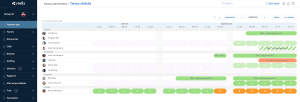
Timesheets in Stafiz
Stafiz's strength? Be able to link time entry to task planning, multi-project management and real-time financial analysis. Teams can thus declare their time directly from their project schedule. The result: time savings for employees, more reliable data entry and immediately identified planned/actual discrepancies.
What are the features of Stafiz?
Stafiz goes far beyond a simple pointing tool. It offers ultra-fine time recording (by the minute, hour, half-day or percentage), perfect for complex or multi-site organizations.
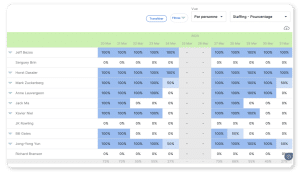
Allocation of working time on the schedule. The boxes are displayed in red in case of overload.
On the data entry side, everything is designed for mobility, efficiency and adoption by field teams.
- Web and mobile application: whether you are in a meeting, on site or on the go, time entry remains fluid, simple and fast.
- Recoverable schedule in the timesheet: the planned tasks are displayed, with their estimated durations, which limits manual entry, facilitates validation, and improves consistency between planned and completed.
- Connectors with professional calendars: Stafiz allows you to import appointments and meetings, which can then be converted into time entered.
- Overload alerts (red visual): on the schedule, employees appear in red when they are over-solicited.
- Automatic integration of leave into timesheets and project planning, to avoid duplication or errors.
The software goes even further:
- it allows profitability to be monitored by project or phase;
- He distinguishes between the activity billable (billable utilization rate) and non-billable (internal projects, commercial projects);
- he calculates the utilization rate to optimize resource occupancy
- it calculates the costs associated with the time spent on activities and projects;
- it automates invoicing according to validated times;
- It includes a hierarchical sheet validation workflow .
- It recalls overdue entries, thus avoiding gaps in the reports.
Each hour entered becomes strategic data re-used for invoicing, the provisional budget or the profitability analysis.
What are the advantages of Stafiz?
Stafiz collects the time spent and transforms it into management data for your entire company. In concrete terms, this means what this means.
- Consolidated data in real time: do you spend too much time cross-referencing Excel files, ERP exports, HR schedules and project reports? With Stafiz, every time entered updates planning, load, finances, and resources in a single tap.
- Automated and accelerated invoicing: as soon as a time is validated, invoicing follows automatically (package, management room, subscription).
- Precise financial monitoring, project by project: each hour entered allows profitability to be monitored in real time. And if there's a budget variance, you'll see an alert before it becomes critical.
- Unified management of the different economic models: fixed price, management or recurring service, Stafiz adapts without imposing constraints on you.
- Seamless integration with your software environment: Stafiz interfaces easily with your ERP, payroll, CRM or accounting software. APIs ensure continuous synchronization, and double entries become a bad memory.
What are the limitations of Stafiz?
Stafiz is designed for strategic steering, not for individual monitoring or intensive field monitoring. Result:
- no built-in stopwatch: no automatic time tracking;
- No clocking machine : typical physical clocking needs Time and Activity management are not covered.
It is a conscious choice: the tool favours proactive planning and collective performance rather than individual micro-monitoring.
Who uses Stafiz?
Stafiz is aimed at service companies with 20 or more employees: consulting firms, software publishers/integrators, IT Services, digital agencies, design offices...
It is the ideal solution for structures that:
- charge for time or expertise;
- manage several projects in parallel, sometimes on different business models;
- are looking to make their margins more reliable and to automate operational management.
But above all, Stafiz is designed to grow with you, to support the growth of your company, whether you go from 20 to 200, or even to 2,000 employees. Our tool remains fluid even in a context of multiple activities, or teams spread across several sites.
Scalable by nature, Stafiz adapts to both SMEs in structuring and international groups, with the same requirement of alignment between time captured, project profitability and strategic decisions.
Opentime
Opentime is a French software that is particularly aimed at consulting firms and service companies thanks to its modular approach. Where some tools impose a rigid architecture, Opentime offers a fine customization of features, adapted to the specificities of each structure.

What are the features of Opentime?
Opentime is a French solution designed for consulting firms and service companies. Its strength: a modular structure, fully customizable according to business needs.
- Time/activity tracking by assignment/project: each employee attaches their hours to a mission, task or project, for clear and actionable tracking.
- Management of leave/absences/schedules: an HR module centralizes requests and automatically integrates their impact into schedules.
- "Project" module (attachments, costs, profitability) according to pack: companies can add the monitoring of project costs and profitability by activating this module.
- Customizable dashboards and reporting: each department (HR, finance, management) adapts its views and exports to its own needs.
- Modularity and configuration : companies activate only the useful bricks (time tracking, leave, expense reports, invoicing), for a tool that is simple at the outset and scalable over time.
This "à la carte" logic limits functional overload and accompanies growth without imposing a rigid architecture.
What are the advantages of Opentime?
Opentime is a flexible tool, designed to stick to business practices rather than imposing a fixed framework.
- A tool that adapts to your processes: each company adapts the software to its monitoring methods and organization.
- Flexible pricing, with no unpleasant surprises: you only pay for what you activate, which allows for a gradual and controlled deployment.
- A good reputation in the French-speaking ecosystem: a software that complies with local standards, appreciated for its understanding of regulatory and HR practices.
Opentime is designed for SMBs that want a tool that is flexible from the start, able to stay in line with your organizational needs as your organization grows.
What are the limitations of Opentime?
Opentime's flexibility is an asset, but it can also become a challenge for some organizations.
- Flexibility that can lead to friction: advanced configuration can be demanding if the company has very specific needs: internal or external support may be necessary to properly configure the tool.
- An increase in international complexity: Opentime may require specific developments to properly manage the diversity of environments with specificities by country or geographical area.
- Ergonomics depend on configuration choices: Opentime's interface is sober, but its use depends heavily on the initial configuration. Poorly thought out, it can generate friction for end users.
Who uses Opentime?
Opentime is suitable for service companies that want to keep control of how they operate. It is a solution appreciated by structures looking for a compromise between simplicity of departure and scalability over time :
- service structures with a need to track time by mission/project;
- Organizations that want to keep some payment flexibility (and pay only for the modules they use);
- SMEs and mid-caps in France who are looking for a locally controlled solution.
Opentime is suitable for companies that want a flexible, scalable tool that is close to their operational realities.
Keeple Time and Activities
Keeple is a 100% French solution, developed by a publisher based in France, which targets SMEs and mid-caps looking for a simple, clear and compliant tool. Its functional scope focuses on the essentials: time tracking, activity management, and time off, without the superfluous.

What are the features of Keeple?
Keeple offers a complete functional base for daily time and absence tracking, with a particular focus on regulatory compliance.
- Time entry by employee / activity / project: the interface is designed for quick entry, both on desktop and mobile.
- Integrated "leave/absence" module: absences are automatically synchronized with the time entered to avoid HR duplication and inconsistencies.
- Alerts on regulatory constraints: automatic controls of working time limits, mandatory breaks and critical thresholds to remain compliant with French law.
- Mobile interface and configurable approval circuit: each employee enters his or her hours wherever he or she is; managers or HR validate via a clear and fluid workflow.
- Planning and projection of load/resources: visibility on periods of high or low load to better anticipate.
Keeple aims for efficiency: everything that is useful in everyday life without superfluous modules.
What are the benefits of Keeple?
- Native compliance with French regulations, particularly for compliance with labour rules. The software controls maximum durations, legal breaks and overtime thresholds.
- A tool that brings together essential modules: time tracking, leave management, load anticipation, the ideal solution for SMEs or mid-caps who want reliable software without having to rethink their entire internal management.
- Ergonomics designed for employees: data entry is fast and accessible on mobile and desktop. The approval circuit is clear, and each user sees what they have to do (even profiles unfamiliar with HR tools).
Keeple is a good compromise between legal compliance, ergonomics and rapid deployment.
What are the limitations of Keeple?
- A deliberately limited scope: Keeple focuses on time tracking, absence management and regulatory compliance. It's not a PSA sequel.
- Limitations for international environments: the tool is very well adapted to the French context, but as soon as your activity extends internationally, with variable legislation, multiple languages or specific hourly rates per country, it shows its limits.
Keeple is aimed at organizations that prioritize simplicity and HR compliance in France.
Who uses Keeple?
Keeple is primarily aimed at French SMEs and mid-caps who want a simple, reliable and compliant tool to manage working time, leave and workload in a French-speaking context.
- SMEs / ETIs in France or in a French-speaking context: a software designed for local standards and practices.
- Structures looking for a local, simple but robust solution for time + leave monitoring: ideal for those who want to avoid an oversized tool.
- Environments where compliance with working time rules is a major issue: for example, for the respect of breaks, overtime and maximum durations.
Horoquartz (SaaS Time Management)
Horoquartz is a French publisher with expertise in time, schedule and access management. Its SaaS timesheet software is designed for complex, multi-site or high-volume environments.
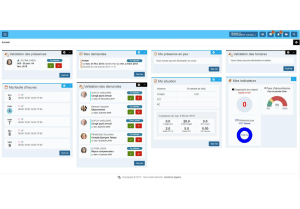
What are the features of Horoquartz?
Horoquartz offers a complete foundation for time management in the field.
- Time and activity management in SaaS mode : employees record their hours via a connected portal, accessible online or via badge readers.
- Scheduling and schedule management : planning of rotations, cycles, compensatory rest, atypical or shift schedules, with a motor adapted to organizations with staggered schedules.
- Integration with badge readers and access control systems : the software synchronizes the actual hours of presence with the physical clock clock to make the data more reliable.
- Adaptability and scalability over large volumes : the solution remains stable and efficient even with several thousand employees spread over many sites.
Horoquartz is particularly useful for companies in which the physical presence of employees needs to be measured, planned and supervised.
What are the advantages of Horoquartz?
Horoquartz is a French reference for companies that need to effectively manage working time, physical presence and access in the field.
- Solid reputation in the French market : 40 years of experience, a strong presence in the public and private sectors, and proven expertise in French labor law.
- Time & Access dimension designed for environments with physical presence : perfect for companies with badge clocking, shift work, or mobile teams.
- Robustness in complex environments : able to absorb heavy constraints such as multiple sites, specific time cycles or large HR staff.
An industrial solution for organizations that need to structure their physical time management, and for whom time management is a strategic lever.
What are the limitations of Horoquartz?
Horoquartz is a complete tool, but it will not be suitable for all organization profiles.
- Less focused on project management or profitability monitoring: it is not a PSA solution, but a Time and Activity management.
- More complex implementation for lightweight structures: Deployment can be costly or cumbersome for multi-sites or complex policies.
- Not suitable for small structures or freelancers: the tool can seem too structuring if access or physical time management is not a central need.
A solution designed for large companies, but too powerful for simpler uses.
Who uses Horoquartz?
Horoquartz is aimed at medium- to large-sized companies that need to manage constraints related to working time, physical presence, or access management.
- Multi-site organizations, with rotating teams, shift work or staggered hours, such as in industry, logistics or the hospital sector;
- Structures that already use badge machines or access control systems, and are looking for a centralized, reliable and integrated solution;
- Environments where time management is critical to compliance, security, or workforce organization.
A perfectly calibrated solution for regulated, technical and highly organized environments.
ManicTime
ManicTime is an automatic time tracking software, which works locally on the user's workstation, with a client and server version for teams.
It is aimed at companies or self-employed people who want to track their working time without having to enter it manually. Unlike project management or planning oriented solutions, ManicTime focuses on analyzing the actual activity on the computer.
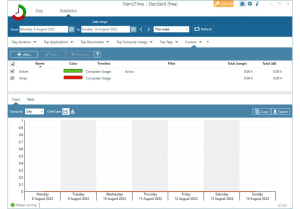
What are the features of ManicTime?
ManicTime automatically records everything that happens on the user's computer, without manual intervention.
- Automatic tracking of the applications and files used: this data can then be associated with projects or tasks;
- Visual timeline for analysis: The interface displays timebars cut by application, making it easy to visualize active and inactive ranges;
- Associate with projects or tasks: the user can then manually (or via rules) assign the detected time ranges to projects or clients;
- Screen recording (screenshots): ability to capture images at regular intervals to provide evidence of activity;
- Local location tracking: on compatible versions, geolocation information can be recorded;
- Offline operation: no internet connection is required for tracking to work. Data is stored locally;
- Absence management : the user can mark his periods of unavailability to prevent automatic tracking from distorting time reports;
- Overtime tracking: ManicTime automatically calculates hours worked, breaks, and overtime.
The tool captures everything that makes up a digital workday without manual entry.
What are the benefits of ManicTime?
- Automatic tracking, no input: the software records in the background without interrupting users' work.
- Objective visibility into actual activity: timelines, histories and screenshots help analyze productivity and serve as evidence when needed
- Suitable for independent work: your activity is not organized into formal missions or budgeted projects? ManicTime nevertheless allows you to better understand how time is used, without imposing a heavy tool on your teams.
A discreet, efficient solution that simplifies daily monitoring through its 100% automatic approach.
What are the limitations of ManicTime?
- Requires automatic post-processing / time assignment to projects or tasks: manual sorting remains essential to make the data usable.
- Less suitable for turnkey "mission + invoicing + validation workflow" uses: it is not a complete PSA or project management solution.
- Risk of intrusive perception : screenshots or automatic tracking can be poorly perceived by employees if the framework of use is not clearly defined beforehand.
Who uses ManicTime?
ManicTime is particularly useful for:
- freelancers and freelancers who want to objectively measure their time without manual re-entry;
- remote or autonomous teams, who need automatic monitoring to understand how their time is distributed;
- Companies looking to produce objective business reports, for example for clients requiring proof of time spent.
It is a simple, discreet and effective solution for those who want to analyze the time actually spent on tasks, without friction in daily use.
TMetric
TMetric is a time tracking solution designed for agile teams, small businesses, and freelancers. Accessible, clear, and well integrated into the ecosystem of project management tools, it makes it easy to track time, calculate profitability, and invoice customers without overly complexity. Its main advantage is that it combines an intuitive interface with well-thought-out project features.

What are the features of TMetric?
TMetric offers a very complete functional base to track the time spent on tasks, clients or projects.
- Manual or timer entry : employees can record their times in real time using a timer, or enter them manually afterwards;
- Tracking of the applications used: in addition to the timer, TMetric can record active software to reconstruct the activity and help break down the times by project or client.
- Detailed reports: The tool generates reports on the time spent, costs incurred, and profitability of projects. This data can be used to adjust budgets or justify services.
- Integration with everyday tools: TMetric easily connects to Trello, Jira, Asana, ClickUp or GitLab. You track time directly in the project management tools already in place, without changing the habits of the teams.
TMetric is positioned as an operational time tracking tool, which is more than enough to cover the needs of a small customer or project-oriented team.
What are the benefits of TMetric?
- A solution focused on concrete needs: Do you need a reliable solution to track your time and manage the profitability of your projects? TMetric installs in minutes, gets started immediately, and requires no heavy tuning.
- An easy interface to get to grips with: don't you want to spend days training your employees? TMetric's UX is fluid, and its operating logic intuitive, which greatly facilitates enterprise adoption.
- Integrations that make tracking smoother: Do you use Jira, Trello or GitLab? TMetric integrates directly into these tools, allowing teams to stay in their usual environment while tracking time effectively.
What are the limitations of ManicTime?
- A limited scope on the HR side : TMetric does not offer advanced modules for the management of leave, absences or hierarchical validations. If you're looking for a tool that can centralize HR processes or comply with complex internal rules, it could quickly show its limits.
- Limitations in terms of advanced financial analysis: if you need to precisely manage your margins, analyze budget variances in depth or integrate financial monitoring at the accounting level, TMetric may lack depth.
Who uses TMetric?
TMetric is particularly suitable for small project teams, freelancers or customer-oriented structures, such as:
- Lawyers, consultants, accountants or freelancers, who want to justify their time effortlessly;
- Support or tech teams, who work on billable tickets or assignments;
- Agencies or associations, which need reporting and traceability functions without setting up a gas plant.
TMetric appeals to those who want a clear, connected and cost-effective time tracking tool, while keeping it simple.
Fanurio
Fanurio is a freelance time and billing tracking tool designed for freelancers or very small teams who want to centralize their activity without unnecessary complexity. Its main advantage is that it brings together all the basic functions necessary for time management and customer invoicing in a compact and quick to implement tool, without depending on a software gas plant.
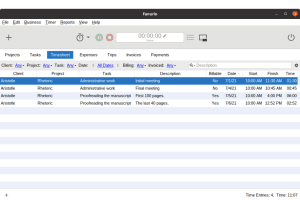
What are the features of Fanurio?
Fanurio offers a narrow, yet coherent functional scope, ideal for those who want to stay focused on the essentials.
- Time tracking by task, client or project: each minute can be assigned to a specific task or to a specific client, with a timer system or manual entry afterwards.
- Integrated invoicing: once the times have been recorded, Fanurio generates invoices directly from the interface. Pricing rules can be customized by customer or service type.
- Simple and clear reports: Users can extract summaries of time spent, revenue generated, or activities by period, client or project.
- All-in-one tool for freelancers: the software combines time tracking, project management, invoicing tracking and reporting in the same work environment.
What are the advantages of Fanurio?
- A compact and efficient tool: Are you looking for a simple solution with no unnecessary features that covers basic time tracking and invoicing needs? Fanurio brings all these functions together in an accessible interface.
- Designed for freelancers: do you work alone or in a very small structure? Fanurio is designed to easily turn your hours worked into invoices.
- An all-in-one without overload: Do you want to avoid juggling between several software? Fanurio centralizes the essentials in a single interface, with a good balance between functionality and lightness.
What are the limitations of Fanurio?
- Unsuitable for large teams : Fanurio is not designed for multi-user operation, with hierarchical validation or planning management.
- Limited functional scope: no HR modules, no advanced leave management, no approval workflow. It is not an enterprise solution, but an individual tool or for small, very agile teams.
Who uses Fanurio?
Fanurio is a solution designed for:
- freelancers, self-employed or micro-entrepreneurs who manage their activity from A to Z;
- small service teams (consultants, developers, graphic designers, etc.) who want a simple and integrated tool;
- Professionals who need a time + invoicing tool, but not a complex HR or project management suite.
Why Should Yo Use A Timesheet Software?
Managing a portfolio of projects without reliable visibility on the time actually spent is like navigating by sight. Time entry is not just an administrative exercise: it is a key lever for securing your margins, anticipating drifts and making your decision-making more reliable. Here's how.
Gain in accuracy and reliability
Sheet and time management software transforms time collection into strategic data that can be used.
- You identify discrepancies by comparing estimated times to those actually consumed. As a result, you anticipate project drifts before they affect the final margin.
- When each hour worked is tracked and valued, your invoicing is based on validated times, reducing the risk of forgetting or disputing the customer.
- The information is no longer scattered in Excel files, but centralized in a single software, ready to be studied according to your analytical axes (project, customer, activity, BU, etc.).
Optimize the profitability of projects
A well-informed timesheet allows you to link actual effort, costs and project performance and allows you to:
- A detailed analysis of costs : how many hours for each deliverable? For each profile? You measure the real load, you refine your future quotes, you manage your margin to date;
- More efficient resource allocation, by comparing time consumed, remaining work and team availability, without underloading or over-mobilizing your employees.
- Better management of your projects (and your project portfolios), thanks to a global vision of the resource planning and load conflicts between competing projects.
Facilitate HR and regulatory management
In addition to project performance, the timesheet software also secures your HR and social obligations via:
- Better regulatory monitoring of working time by alerting you in the event of exceeding maximum working hours, overtime and mandatory rest periods. This facilitates both day-to-day management and audits in the event of an audit;
- more transparency and autonomy for the teams, because each employee can view their time entered, understand their workload, and follow up on their leave requests;
- a clear UX that makes the use of the tool more fluid: less friction = more rigor in the entry = reliable data on a daily basis.
What Features To Look For In A Timesheet App?
Not all time tracking apps are created equal. For timesheet software to be truly useful for teams, managers, and management, it must cover the entire cycle: from time entry to analysis, operational management, invoicing, and regulatory compliance.
To enter and track working time
The tool must be able to facilitate the declaration of time, regardless of the context in which the employee entered the data (office, field, teleworking), or the nature of the project. Here are the features to consider:
- The granularity related to your context: per minute, hour, day, week, or custom time period.
- the input mode in the tool : via a start/stop timer, by keyboard input, by selecting from a drop-down menu;
- the input medium : access via computer, tablet, mobile application;
- Tracking billable vs. non-billable time : the tool must be able to differentiate between customer times (billable utilization rate), internal or unproductive (occupancy rate).
To manage projects
As soon as it connects the time entered to the reality of the project, the software becomes a real operational management tool.
- Actual vs. Forecast Tracking: Compare estimated times to actual time spent to detect discrepancies as soon as they appear.
- Consolidated view across multiple projects simultaneously (or a portfolio): View the overall load to avoid overbooking or the sub-resource planning.
- Track deliverables and milestones: Assign time to tasks, project phases, or deliverables for precise management, beyond resources alone.
To invoice and generate profit
Timesheets must be used directly for invoicing and the measurement of profitability:
- Automated invoicing based on timesheets, so that each declared hour forms a reliable basis for issuing invoices.
- calculation of margins and costs to monitor profitability by project or customer in real time;
- Management of daily/hourly rates by integrating specific rates by profile or mission.
Integrations and automations
Timesheet software must be fully integrated into your IS to streamline your processes.
- A connection with HR and financial tools : payroll, ERP, accounting, CRM.
- Automated exports : generating reports, sending data to other tools.
- API and interoperability: avoid double entries and centralize information flows.
Reporting and analysis
Time data becomes a management tool when it is analyzed in a transversal and dynamic way. Here are what reporting features to look for in timesheet software:
- Personalized dashboards : productivity tracking, time per customer, occupancy rate.
- Load/capacity analysis : visualization of the availability of the teams.
- Consolidated reports : comparisons by period, project, BU or employee.
HR Management & Compliance
A robust timesheet solution must also secure the management of social obligations:
- Leave and absence tracking: direct integration with the schedule and timesheets;
- compliance with labour law: monitoring of overtime, rest periods, legal obligations;
- Hierarchical validation: validation workflow to control entries before exploitation.
What is the best timesheet software in 2025?
The timesheet is no longer a simple administrative tool: it has become the basis for the management of many service companies. Choosing the right software directly influences team productivity, reporting quality, and project profitability.
Our comparison shows that there is no one-size-fits-all solution:
- Stafiz is a must for multi-project, margin-oriented SMEs thanks to its dynamic planning and automated invoicing.
- Opentime and Keeple seduce by their simplicity and their adaptation to the French context, the first for its modularity, the second for its HR compliance.
- Horoquartz remains the reference for multi-site industrial environments with badge readers and complex schedules.
- TMetric and Fanurio offer a lightweight and affordable solution for freelancers or small teams looking for a time tracking and invoicing tool.
- Finally, ManicTime is aimed at those who want to automate tracking without manual entry.
Before making a decision, determine your priorities: granularity of entry, financial management, regulatory compliance or automatic monitoring. Then check the scalability (ability to support your growth), interoperability with your tools (ERP, CRM, payroll) and the level of support from the supplier.
Whether you're starting with a free project timesheet software, or considering a full collaborative SaaS, choosing the right tool will help you centralize your data, reduce forecast/actual gaps, and sustainably improve your margins.
Questions:
For basic use and a very small number of users, an Excel timesheet may be sufficient. However, as soon as you need more features (approval, detailed reports, payroll or billing integration), or for any growing team, specialized software becomes essential. It offers more reliability, data security and saves a lot of time through automation.
Yes, many modern timesheet software natively integrate absence and paid leave management. These tools allow you to centralize the request, approval and monitoring of leave balances, providing an overview and simplifying pre-payroll.
Emphasize the benefits they get: speed of entry, clarity on their hours worked, and simplification of leave requests. Explain that this tool ensures fair and accurate invoicing and payroll, and support the deployment with simple and engaging training. Emphasize that the goal is to optimize time, not to monitor.


